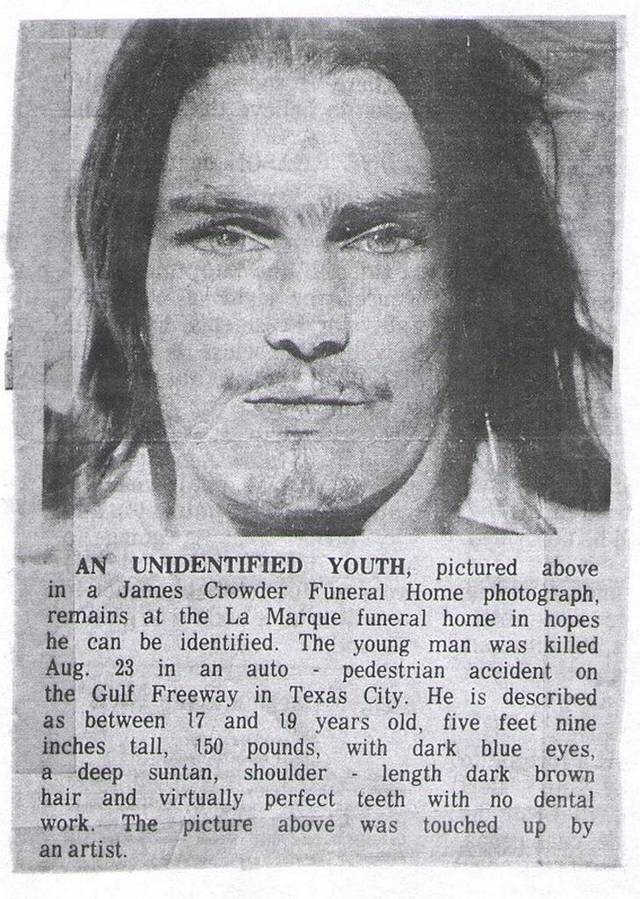
The Scope of the Missing Persons Phenomenon
When we hear the word “missing” we often think of missing children. When we walk into Walmart the faces of missing children stare back at us and the missing child cases that receive public and media attention are often the most extreme examples, such as the case of Ayla Reynolds.
One-year-old Ayla Reynolds vanished from her home on December 16, 2011, in Waterville, Maine. Her arm in a sling, Ayla was last seen wearing green pajamas with “Daddy’s Princess” on the front. Six years later, Ayla’s disappearance remains a mystery.

(Poster of Ayla Reynolds distributed by the National Center for Missing & Exploited Children at www.missingkids.com.)
It is quite common there is less concern for adult missing, further obfuscating an already complex issue.
The most reliable overall missing person statistics are maintained at the National Crime Information Center (NCIC), at the Federal Bureau of Investigation to include all ages of missing persons to include age, race, gender, and category of disappearance.
What is NCIC?
Called the lifeline of law enforcement, NCIC is a clearinghouse of crime data that can be accessed by every criminal justice agency in the country. It assists criminal justice professionals to locate missing persons, apprehend fugitives, recover stolen property, and even identify terrorists.
Launched in 1967, with five file categories and 356,784 records, by 2015, NCIC contained 21 file categories and 12 million records, averaging 12.6 million transactions per day.
The NCIC Missing Person File was implemented in 1975. Records entered in the Missing Person File are retained indefinitely, until the person is located, or the record is canceled by the entering investigating law enforcement agency.
According to the NCIC, as of May 31, 2018, there were 87,608 active missing person cases in the United States, some cases dating back decades. Juveniles 18-years old and under accounted for 31,580 active cases in NCIC.
But, what exactly does this mean? And, who are all of these missing persons?
Missing persons entered into NCIC range from birth to age 99-years old and can include children to a senior with Alzheimer’s disease. Unfortunately, there are no statistics available to narrow down the contributors specific to an individual’s disappearance such as a history of domestic violence, mental illness, diminished mental capacity such as Alzheimer’s, those living a high-risk lifestyle, etc. However, missing persons are entered into six categories within NCIC.
Within NCIC, the Missing Person file includes the following six categories of missing person entries and defined by the FBI as follows:
Juvenile: Person under the age of eighteen who is missing and does not meet any of the entry criteria set forth in the other categories.
Endangered: Person of any age who is missing under circumstances indicating physical safety may be in danger.
Involuntary or Nonfamily Abduction: Person of any age who is missing under circumstances indicating the disappearance may not be voluntary (abduction or kidnapping).
Disability: Person of any age who is missing under proven physical or mental disability or is senile with the potential of subjecting him/herself or others to personal and immediate danger.
Catastrophe Victim: A person of any age who is missing after a catastrophe such as a flood, avalanche, fire, or other disasters.
Other: Person over the age of 18 not meeting the criteria for entry in any a category who is missing and there is reasonable concern for safety.

(Source: NCIC Missing Person Analysis as of May 31, 2018)
When an individual is reported missing to a law enforcement agency, the missing person’s descriptive data is entered into the NCIC computer to include full description, age, race, gender, clothing, jewelry, scars, tattoos, past surgeries, vehicle description, and any other related descriptive data is entered into the computer database and placed into a specific category based upon an initial determination by the investigating law enforcement agency if the person may be endangered due to circumstances surrounding the person’s disappearance, possible foul play, or a disability.
Unfortunately, with missing persons, the cause of the disappearance may not always be clear. Unlike a homicide, where evidence may be collected to help the investigation progress, many times, there is no scene of a crime for police to analyze – a person simply vanishes.
Missing Child Act of 1985
In 1984, the United States Congress passed the Missing Children’s Assistance Act, which established a national resource center and clearinghouse for missing children. In 1984, the National Center for Missing & Exploited Children (NCMEC) was created by President Ronald Reagan.
Primarily funded by the United States Department of Justice, Office of Juvenile Justice & Delinquency Prevention (OJJDP), NCMEC acts as an information clearinghouse and resource for families of missing children, law enforcement, and communities to assist in locating missing children and to raise awareness about way to prevent child abduction, child sexual abuse, child pornography and child sex trafficking.
On April 6, 2018 it was announced in Forbes Magazine that the United States Department of Justice, in a joint effort with the Federal Bureau of Investigation, Internal Revenue Service, and the U.S. Postal Inspection Service had seized and shut-down Backpage.com, considered a constant opponent of NCMEC due to it’s facilitation of child sex trafficking. In the battle against child sex trafficking, the world waits to see what happens with the case against Backpage.com.
NCMEC and the OJJDP utilizes enhanced definitions of missing children as follows:
- Family Abduction is defined as a member of the child’s family or someone acting on behalf of a family member takes or fails to return a child in violation of a custody order or other legitimate custodial rights and conceals the child, transports the child out of state with the intent to prevent contact, or expresses the intent to deprive the caretaker of custodial rights permanently or indefinitely.
- Nonfamily Abduction is defined as a nonfamily perpetrator, without lawful authority or parental permission, uses force or threat to take a child (at least 20 feet or into a vehicle or building), or detains a child in a place where the child cannot leave or appeal for help for at least one hour, conceals the child’s whereabouts, demands ransom, or expresses the intent to keep the child permanently.
- Stereotypical kidnapping (nonfamily abduction subtype) is defined as a nonfamily abduction perpetrated by a stranger, person of unknown identity, or slight acquaintance in which the perpetrator kills the child, detains the child overnight, transports the child at least 50 miles, demands ransom or expresses to keep the child permanently.
- Runaway is defined as a child who leaves home without permission and stays away overnight.
- Thrownaway is a defined as a child whom an adult household member tells to leave or prevents them from returning home and does not arrange for alternative and adequate care.
- Missing Involuntary (lost, stranded, or injured), is defined as a child whose whereabouts are unknown to the caretaker, causing the caretaker to contact law enforcement or a missing child agency to locate missing child.
- Missing (benign explanation) is defined a child whose whereabouts are unknown to the caretaker, causing the caretaker to become alarmed for at least one hour, try to locate child, contact police about the episode for any reason, as long as the child does not fit any of the above episode types.

(National Incidence Studies of Missing, Abducted, Runaway and Thrownaway Children (NISMART) comparison of NIMART-3 2013 study and NISMART-2 1999 study.)
What Determines Entry in NCIC
Public Safety Telecommunications personnel are responsible for first response to incident of missing persons and entrusted with the critical task of gathering, organizing, and entering identifying information into the NCIC database. They also play a crucial role in making queries as well as executing record updates, modifications, and cancellations.
Missing persons are entered into an NCIC category based upon information gathered from family members, friends and potential witnesses, while detectives respond and investigate the last known whereabouts of the missing individual.
Entry into a specific category is determined by information that is collected at the scene and based upon the initial information collected. As information is collected, an initial determination is made that can be modified later based upon any new information that is obtained.
For example, a family comes home to find their 13-year old daughter is gone. Recently, she has been threatening to run away and the parents first assume that is what happened. They call police who respond to the house. At that point, she may initially be entered in NCIC as Endangered. However, upon further questioning, the family soon discovers she did not pack anything and her cell phone is found on the living room floor. Police investigate further and discover the screen to the back door is cut and it appears the house was entered by someone other than family. Very quickly, an Endangered Missing Person case can become an investigation of a critical Involuntary Missing Person.
At that point, in the case of the most serious cases of missing children, an immediate notification is made to the FBI and NCMEC to enable them to arrange resources. If given permission by the investigating law enforcement agency, NCMEC may also issue an AMBER Alert.
Each case if different, circumstances vary. Whether an individual may have vanished on their own, to one who may have schizophrenia or Alzheimer’s disease, entry into NCIC will depend upon the determination made by law enforcement based upon their initial response and ongoing investigation
Nonfamily Abduction
It was June 9, 1995, on a beautiful evening in the small town of Alma, Arkansas. Alma is located along I-40 within the Arkansas River Valley at the edge of the Ozark Mountains with a population under 5,000 people.
That evening was the first time 6-year old Morgan Nick had gone to a baseball game. Her mother Colleen was attending the Rookie League game at the Alma ballpark and Morgan had whined about having to sit next to her mother in the bleachers. There was a nearby sand pile with other children playing and Morgan wanted to play. It was within eyesight and only seconds away, so Colleen consented.

(Morgan Nick, age 6, vanished from Alma, Arkansas on June 9, 1995.)
Morgan ran to the sandpile, laughing with the other children while Colleen turned her head back to watch the Marlins and Pythons. A player whacked the ball and two runners tied the game, then a run was scored, and the Pythons won the game. The sound of the crowd cheering was deafening.
When Colleen stood up she could see Morgan’s playmates walking down the hill away from the sandpile, but where was Morgan? It was approximately 10:30 p.m.
The children told Colleen that Morgan was pouring sand out of her shoe near her mother’s car parked nearby. Colleen frantically searched. Morgan was gone.
Later, the children would tell police they saw a man approach Morgan. Another abduction attempt had occurred in Alma that day and police had a composite sketched based on witnesses of the other incident.
Thousands of leads later, numerous appearances on national news talk shows, even America’s Most Wanted, and Morgan’s mother is nowhere closer to knowing what happened to her daughter that evening. Police have interviewed hundreds of persons of interest, searched homes and wells, and dug up slabs of concrete with backhoes, but Morgan remains missing 23 years later.
The stakes are high when a person vanishes involuntarily and the search.
Missing with disabilities
Patty Mosley is a 66-year old woman with dementia who had been placed in a Maple Heights medical center in Cleveland, Ohio and went missing on April 21, 2018.
According to Police Detective Lieutenant Grossmyer, it appears Patty just walked away from the facility. Broadway Care Center, a nursing and rehabilitation center, has not made a statement regarding how Patty was able to get out of the facility. “They weren’t sure how she had gotten out of the facility,” Grossmyer said.

(Patty Mosley, age 66 with early onset of dementia, vanished from a care facility in Ohio on April 21, 2018.)
Patty had been diagnosed with major depression, dementia, alcoholism and other brain disorders.
Police issued a public “Missing Endangered Adult” alert, searched all local hospitals, RTA stations, and women’s shelters, even calling in their search team. All local media covered the story.
“We went into individual businesses, establishments, we checked people up and down the streets. We have checked everywhere we can and the information was put out throughout Northeast Ohio,” Grossmyer said.
Sadly, Patty is not the only individual to have disappeared from Broadway Care Center. In June 2017, 52-year old Francis Kish “walked out” of the facility and vanished. A paranoid schizophrenic dependent upon medication was later found safe at an RTA station.
Patty was also found safe and the NCIC entry cancelled by Maple Heights Police Department. A happy ending.
However, these are not isolated incidents. Mark Billiter who suffered from Alzheimer’s walked out of Glenwood Care & Rehabilitation in Canton and was later found deceased near a gas station having died from exposure to the cold.
There are 5,731 individuals entered into NCIC with disabilities that include physical disabilities, those needing medications, missing persons with schizophrenia, bipolar, dementia, Alzheimer’s disease, and other incapacitating disabilities.
When an individual who has disabilities, especially diminished mental capacity, goes missing, it is vital the search is initiated quickly.
Endangered Missing – Few Clues
It has been 21-years since Kristen Modafferi has been seen.
Kristen, 18, was an honor roll design student at North Carolina State University. She planned to spend her summer in San Francisco studying photography at U.C. Berkeley with classes scheduled to begin on June 24. She waved goodbye to her parents on her birthday June 1, 1997 and boarded the plane to San Francisco. It was the first time she had been on her own.

(Kristen Modefferi vanished in San Francisco on June 23, 1997.)
Kristen quickly found employment at Spinelli’s Coffee Shop in the Crocker Galleria and worked there during the week and weekends at the Café Museo, located inside the Museum of Modern Art. The adventurous young lady was in her element.
On June 23, the day before classes were to begin, Kristen asked a coworker at Spinelli’s for directions to Baker Beach, next to the popular Land’s End Beach. She proceeded to clock out at 3 p.m. and was last seen by a coworker at approximately 3:45 p.m. on the second floor of the Crocker Galleria with an unidentified blonde woman. The coworker thought it strange because Kristen normally left the mall immediately after shift’s end. That was the last time Kristen was seen. She never returned for her $400 paycheck.
Upon learning of Kristen’s disappearance, her parents Bob and Deborah immediately flew to San Francisco and met with police.

(Baker Beach, near Land’s End beach is approximately 6 miles from the Crocker Galleria where Kristen was last seen.)
Kristen’s scent would be tracked by bloodhounds from the Crocker Galleria to a nearby bus stop that leads to Sutro Park Beach, next to Land’s End. Bloodhounds picked up her scent again at the beach but lost it at a high cliff. Police feared she may have fallen to her death at the beach.

(Land’s End Beach where bloodhounds search for Kristen Modafferi.)
Police then found a personal ad that read, “Friends: Female seeking friends to share activities, who enjoy music, photography, working out, walks, coffee, or simply the beach, and exploring the Bay area. Interested, call me.” Authorities believed Kristen had responded to or placed the ad in the local paper.
Authorities suspected the person who answered or placed the ad was the unidentified blonde seen at the mall with Kristen and somehow, she may be involved in Kristen’s disappearance.
On July 10, 1997, local news station KGO, an ABC affiliate, received an anonymous phone call from a man who claimed two lesbians had kidnapped Kristen, murdered her and dumped her body under a bridge at Point Reyes in Marin County. When police interviewed the two women Jon had identified they told detectives Jon was angry with them spurring the phone call. Jon then claimed he had learned about the case from television.
Shortly thereafter, three women came forward claiming Jon liked to abuse and torture women and often targeted women using personal ads while using other women to lure his victims.
One of the women who came forward told police Jon had mentioned Kristen by name, threatening her, “the same thing that happened to her could happen to you.”
Police searched Jon’s girlfriend’s residence and found a diary that had pages ripped out that correlated with the dates Kristen went missing. She told them that Jon had ripped the pages out because they may have contained incriminating information.
Though they polygraphed Jon, there was never enough evidence to make an arrest.
Private investigators hired by Kristen’s family believe Kristen was murdered in the basement of her residence though there has never been any information or DNA evidence to substantiate those claims.
21 years later, Kristen remains missing.
Other – At Risk Missing

(Corinna Slusser vanished in NYC on September 20, 2017.)
Life was different two years ago for Sabina Tuorto, mother of 19-year old Corinna Slusser who has been missing since September 20, 2017.
“Only two years ago, so much was different then. My daughter was a great student, a cheerleader. She had many friends and lived her life as a normal teenager,” said Sabina. “I need her home and I can’t bear any more days like this. I fear the worst, but I pray for the best and her return home . . . waiting for an Angel to hear my prayer.”
Corinna was last seen at Haven Motel in Queens, New York on Woodhaven Boulevard, approximately 5 miles from LaGuardia Airport.
According to online Yelp reviews of the budget hotel, the consensus is the place needs to be shut down.
“I live right by the place and feel compelled to review it. It’s a motel mostly for prostitutes – seriously. The cops are constantly out investigating it and there’s always an issue. Parking lot is generally full of minivans (vom). It goes on an hourly rate. The windows are tinted 100% black. Repulsive. This place should seriously be shut down,” wrote one reviewer.
Corinna was last seen leaving the hotel during the early morning hours of September 20th.
Before the bright and cheery high school cheerleader’s disappearance, Corinna lived in Bloomsburg, Pennsylvania, and dreamed of becoming a makeup artist. On her Instagram account, which she updated almost daily, she is often dressed in bohemian type clothing showing peace signs, photographed hugging her friends and enjoying the outdoors.
However, one can see a transition occurring in the photographs she posted. Corinna goes from a bright and bubbly teen to showing less modest photographs.
An Instagram post uploaded on September 11, 2017, is thought to have been taken in the Bronx. The caption reads “cyphin mid day mid road is always good for the soul.”
There has been no activity on any of her social profiles since her disappearance.
While living in Bloomsburg, Corinna had become depressed and landed in the hospital where she met an older man that persuaded her to move to New York City. He offered a place to stay for the adventurous teen. Little did she know, the 32-year old man was a suspected “pimp” from Harlem. She took with her only her cell phone, identification and what she was wearing and moved to the bustling city where police believe she was coerced into prostitution.
Initially, Corinna kept in touch with family and friends and posted to her social media accounts.
With multiple arrests for “promoting prostitution, the man she left with was known by police in New York City. NYPD detectives now theorize Corinna has been moved from pimp to pimp and no longer in the city. Her name has been mentioned in various vice investigations and they fear she has been kidnapped by a sex trafficking ring.
One month prior to her disappearance, her mother received a copy of an order of protection revealing her daughter had been an assault victim on August 25, 2017.
Corinna had made a 911 call from the Harlem Vista Hotel in Northern Manhattan telling police she had been assaulted by her pimp. She accused him of grabbing her around the neck, smashing her head against the wall and strangling her after she confronted him of stealing $300 from her. The document named the man she had left with as Yovanny Peguero. When confronted by her mother she tried to downplay the incident.
When Corinna failed to show up for her grandfather’s funeral in Florida she was reported missing.
There is a $10,000 reward offered for information that leads to the safe recovery of Corinna Slusser.
Experts in the Field of Missing Persons and Sex Trafficking
These are typical cases that populate NCIC and each vastly different from the other.
Thomas Lauth of Lauth Investigations has worked over 20 years throughout the country and internationally on endangered missing person cases.
“The most important thing a family can do when a loved one is missing is pull in as many resources as possible,” says Lauth. “Finding missing persons is a cooperative effort between police, media, missing person experts and advocates, private investigators and especially the public.”
According to missing person experts, the more time that goes by, the less likely the person will be found alive. However, with cases like Jaycee Dugard, kidnapped by a stranger on June 10, 1991 at age 11, and found alive in 2009, there still remains hope for every family.





 For months, the family of 5-year-old Lucas Hernandez wondered if they would ever have answers in his mysterious disappearance. On the day he disappeared, he was left in the care of his father’s girlfriend, Emily Glass. In the missing persons report Glass gave to investigators,
For months, the family of 5-year-old Lucas Hernandez wondered if they would ever have answers in his mysterious disappearance. On the day he disappeared, he was left in the care of his father’s girlfriend, Emily Glass. In the missing persons report Glass gave to investigators,  Unfortunately, family members and locals will never have the truth about what happened to Lucas. In the wake of the private investigator’s discovery, autopsy reports were found to be inconsistent with what Glass told both police and the PI, but before the People could build a case against her, Glass was found dead from an apparent suicide. However, were it not for the efforts of the private investigator, Lucas’s father may never have had answers in his son’s disappearance.
Unfortunately, family members and locals will never have the truth about what happened to Lucas. In the wake of the private investigator’s discovery, autopsy reports were found to be inconsistent with what Glass told both police and the PI, but before the People could build a case against her, Glass was found dead from an apparent suicide. However, were it not for the efforts of the private investigator, Lucas’s father may never have had answers in his son’s disappearance.

 according to Associated Press. The young man, Joseph Spears, was never seen or heard from again by his family. A month later, an unidentified teenager was killed in Texas City, Texas while trying to cross a freeway on August 23, 1973. The community of Texas City raised money to give the unidentified teenager a funeral and grave.
according to Associated Press. The young man, Joseph Spears, was never seen or heard from again by his family. A month later, an unidentified teenager was killed in Texas City, Texas while trying to cross a freeway on August 23, 1973. The community of Texas City raised money to give the unidentified teenager a funeral and grave.








 family strongly believes that Sheriff Russell never thoroughly investigated the disappearances of Molly and Colt in order to protect Nipp, his cousin. Paula Fielder, Miller’s cousin, told The Daily Beast “Sheriff Russell… refused to allow her family to file a missing person report within days of Miller’s disappearance. The Love County dispatcher told relatives they needed to file a report with the Wilson Police Department because it was not Russell’s ‘problem’.” Fortunately, a grand jury has since filed charges against Sheriff Russell in order to remove him from office. However, since the Sheriff was released from jail he has returned to work. Miller’s family hopes that Sheriff Russell’s pending arrest will finally bring them answers.
family strongly believes that Sheriff Russell never thoroughly investigated the disappearances of Molly and Colt in order to protect Nipp, his cousin. Paula Fielder, Miller’s cousin, told The Daily Beast “Sheriff Russell… refused to allow her family to file a missing person report within days of Miller’s disappearance. The Love County dispatcher told relatives they needed to file a report with the Wilson Police Department because it was not Russell’s ‘problem’.” Fortunately, a grand jury has since filed charges against Sheriff Russell in order to remove him from office. However, since the Sheriff was released from jail he has returned to work. Miller’s family hopes that Sheriff Russell’s pending arrest will finally bring them answers.